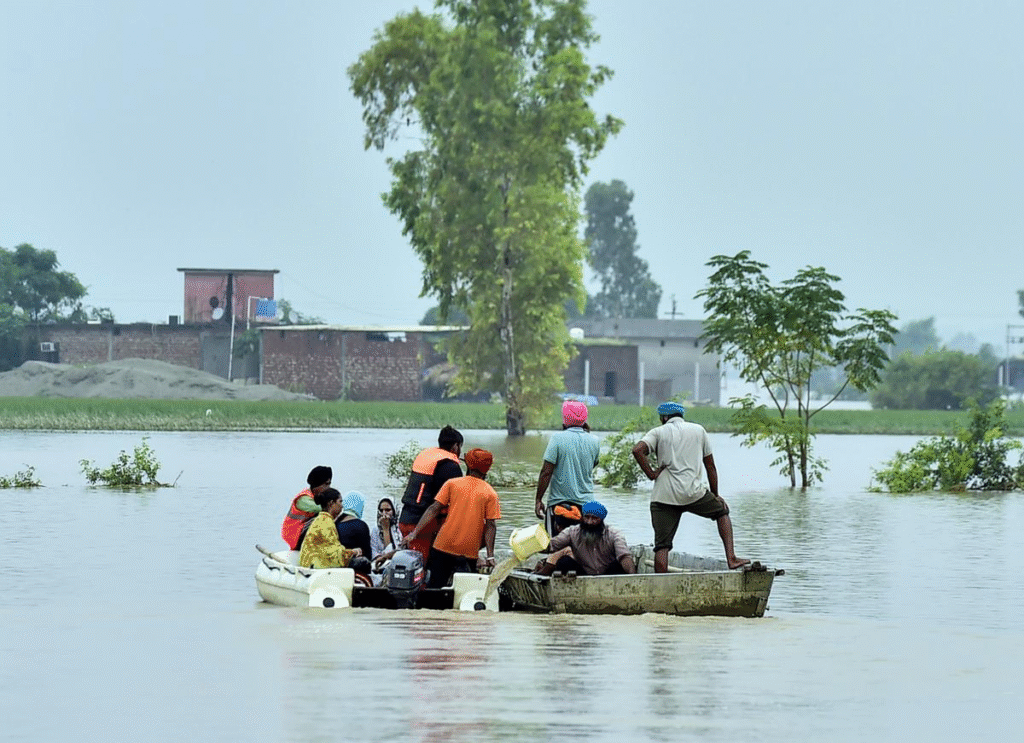
The state of Punjab is grappling with one of the worst Punjab Floods floods in decades. Relentless monsoon rains have inundated villages, destroyed farmland, and forced mass evacuations. As officials confirm rising casualties and losses, the scale of the humanitarian and agricultural crisis is becoming clear.
Punjab Floods: Key Highlights at a Glance
- Dozens of lives lost across the state
- Hundreds of thousands affected by flooding
- 1.75 lakh acres of farmland submerged under water
- All 23 districts impacted, making this a statewide disaster
- Rescue operations ongoing with drones, boats, and airlifts
Heavy Rains Trigger Widespread Flooding
In the first week of September, unusually heavy monsoon rains lashed Punjab. Rivers and drainage channels overflowed, breaching embankments and inundating vast stretches of farmland. Consequently, villages and towns were submerged within hours, forcing families to flee with little more than the clothes on their backs.
Human Toll: Families Displaced Overnight
The Punjab floods have displaced tens of thousands of people, many of whom are now living in relief camps. Reports confirm dozens of fatalities, with more expected as rescue operations continue. Elderly residents, children, and livestock have been among the most vulnerable.
Health officials have warned of secondary risks, including:
- Contaminated drinking water
- Waterborne diseases such as cholera and diarrhea
- Shortage of medicines and clean sanitation facilities
Punjab’s Agriculture: A Granary Under Water
Known as India’s breadbasket, Punjab has suffered massive agricultural losses. Around 1.75 lakh acres of farmland are reported submerged, damaging wheat, rice, and vegetable crops. For farmers, this means:
- Immediate income losses
- Shortages of fodder for livestock
- Uncertainty about the next sowing cycle
The long-term consequences could ripple across India’s food supply chain if recovery is delayed in Punjab floods.
For more information and updates on Punjab Floods click on website link
Checkout youtube channel for new vidoes on Punjab Floods link
Relief and Rescue Efforts for Punjab Floods
Authorities have deployed the NDRF, SDRF, and Army units for relief and rescue operations. Drones and boats are being used to deliver essentials such as food packets, medicines, and water to cut-off villages. Relief camps are being set up in schools and community halls across the state.
Volunteers and NGOs are also stepping in, distributing dry rations and providing emergency healthcare. However, the scale of devastation demands continued assistance and coordination with central government agencies.
Immediate Needs on the Ground
The following areas require urgent attention:
- Shelter & Evacuation: More relief camps and safe housing are required in Punjab floods affected areas.
- Clean Water & Hygiene: Safe drinking water and sanitation kits are essential.
- Medical Aid: Mobile clinics and doctors are needed in flooded zones.
- Livestock Protection: Fodder and veterinary services to save cattle.
- Agricultural Support: Seeds, fertilizers, and financial aid to restart farming.
Why Such Floods Are Becoming More Frequent
Climate experts note that extreme monsoon events are becoming more common, driven by warming oceans and increased atmospheric moisture. In addition, unplanned urbanization and poor drainage infrastructure have worsened Punjab’s vulnerability.
This disaster is a stark reminder that climate resilience — through stronger embankments, improved drainage systems, and better early-warning mechanisms — must be prioritized.
Stories From the Ground
Volunteers describe heart-wrenching rescues — families stranded on rooftops, children carried in buckets across waterlogged streets, and cattle swimming to survive. These human stories highlight not just the scale of destruction in Punjab Floods but also the resilience and solidarity of Punjab’s people.
How You Can Help for Punjab Floods
If you wish to contribute for Punjab floods, here’s how:
- Donate to verified state relief funds and trusted NGOs for Punjab Floods.
- Support local organizations providing food, clean water, and medicines.
- Volunteer if you are in a position to assist with relief operations.
- Spread awareness by sharing verified information and donation links.